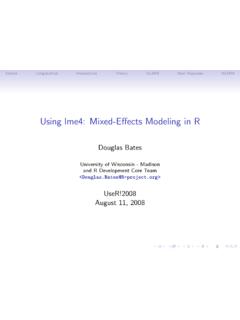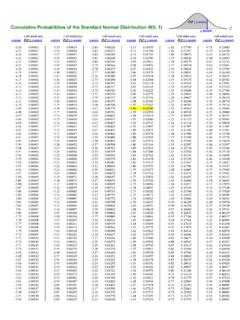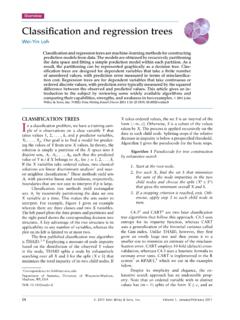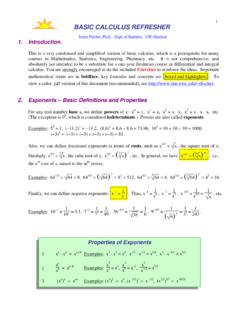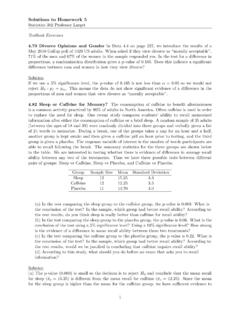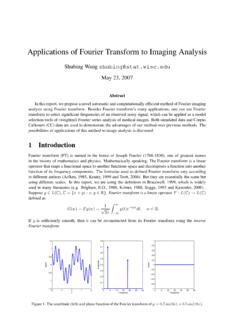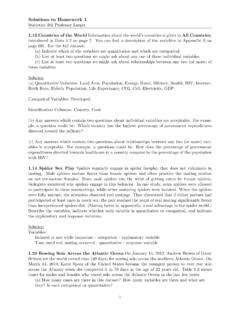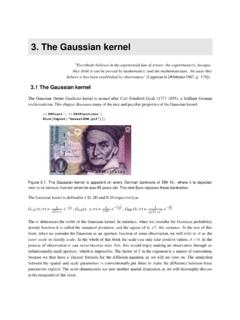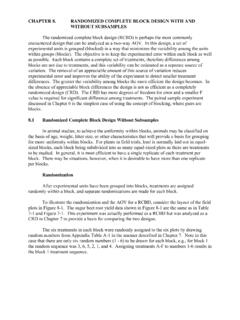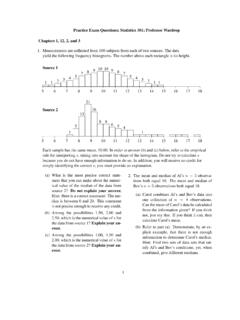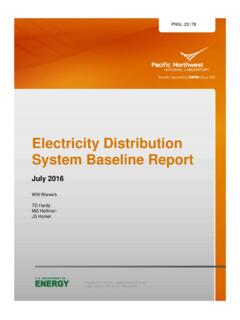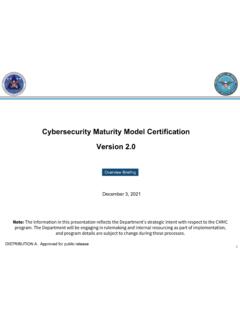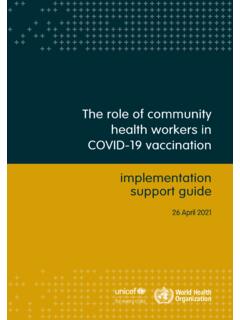Transcription of Chapter 4 The Poisson Distribution
1 Chapter 4 The Poisson The Fish Distribution ?The Poisson Distribution is named after Simeon-Denis Poisson (1781 1840). In addition,poissonis French for this Chapter we will study a family of probability distributions for a countably infinite samplespace, each member of which is called aPoisson Distribution . Recall that a binomial distributionis characterized by the values of two parameters:nandp. A Poisson Distribution is simpler in thatit has only one parameter, which we denote by , pronouncedtheta. (Many books and websitesuse , pronounced lambda, instead of .) The parameter must be positive: >0. Below is theformula for computing probabilities for the (X=x) =e xx!,forx= 0,1,2,3, ..( )In this equation,eis the famous number from calculus,e= limn (1 + 1/n)n= ..You might recall from the study of infinite series in calculus, that x=0bx/x! =eb,for any real numberb. Thus, x=0P(X=x) =e x=0 x/x!
2 = , we see that Formula is a mathematically valid way toassign probabilities to the nonneg-ative mean of the Poisson is its parameter ; = . This can be proven using calculus and asimilar argument shows that the variance of a Poisson is alsoequal to ; 2= and = .33 When I writeX Poisson ( ) I mean thatXis a random variable with its probability distribu-tion given by the Poisson with parameter value .I ask you for patience. I am going to delay my explanation of why the Poisson Distribution isimportant in probabilities can be computed by hand with a scientific calculator. Alternative, youcan go to the following website: will give an example to illustrate the use of this Poisson ( ). The website calculates two probabilities for you:P(X=x)andP(X x). You must give as input your value of and your desired value ofx. Suppose that IhaveX Poisson (10) and I am interested inP(X= 8). I go to the site and type 8 in the boxlabeled Poisson random variable, and I type 10 in the boxlabeled Average rate of success.
3 Iclick on the Calculate box and the site gives me the following answers:P(X= 8) = (Appearing as Poisson probability ) andP(X 8) = (Appearing as Cumulative Poisson probability ).From this last equation and the complement rule, I getP(X 9) =P(X >8) = 1 P(X 8) = 1 = can be shown that if 5the Poisson Distribution is strongly skewed to the right, whereas if 25it s probability histogram is approximately symmetric andbell-shaped. This last statementsuggests that we might use the snc to compute approximate probabilities for the Poisson , provided is example, suppose thatX Poisson (25) and I want to calculateP(X 30). We will usea modification of the method we learned for the , we note that = 25and = 25 = 5. Using the continuity correction, we replaceP(X 30)withP(X ). We now standardize:P(X ) =P(Z ( 25)/5) =P(Z ).Finally, we approximate this probability forZby using the snc and obtain With the helpof the website, I find that the exact probability is summarize, to approximateP(X x)forX Poisson ( ), Calculatez= (x )/.
4 Find the area under the snc to the right is unknown we can use the value ofXto estimate it. The point estimate isxand, followingthe presentation for the binomial, we can use the snc to obtain an approximate confidence intervalfor . The result is:x z is an example of its assumes thatXhas a Poisson Distribution , but does not know the value of . He observesx= 30. His point estimate of the mean is 30 and his 95% confidence interval is30 30 = 30 = [ , ].We will now investigate the accuracy of the snc approximation. Suppose that, in fact, = 95% confidence interval will be correct if, and only if,X X 40 X+ algebra, this becomes(31 X 55). The probability of this event, from the website, , which is pretty close to the desired repeated this analysis (calculating the exact probability that the CI is correct) for severalvalues of ; my results are below. :10050403530 Exact Prob.
5 Of Correct my opinion, the snc approximation works adequately for 40. If you believe that might besmaller than 40 (and evidence of this would be ifXwas smaller than 40), then you might want touse an exact method, as I illustrated for the binomial. Thereis a web site that will do this for you;go to: site can be used for one- or two-sided CI s. Here is an assumes thatX Poisson ( ) but does not know the value of . He observesX= 3andwants to obtain: The two-sided 95% CI for ; and The upper one-sided 95% CI for .I will use the website to find Bart s CI s. I type 3 (the valueofX) into the Observed Events: box and click on compute. (I don t need to specify the confidence level b/c the 95% two-sided CIis the default answer for this site.) I get[ , ]as the exact two-sided 95% CI for .For the one-sided CI, I scroll down and type 5 in the upper tail box and 0 in the lower tail box.
6 Then I scroll up and hit compute. I get the CI:[ , ]. This is clearly a computererror round-off error b/c the lower bound must be 0. So, theanswer is that is the 95%upper bound for . Poisson Approximation to the BinomialEarlier I promised that I would provide some motivation for studying the Poisson have seen that for the binomial, ifnis moderately large andpis not too close to 0 (remem-ber, we don t worry aboutpbeing close to 1) then the snc gives good approximations to binomialprobabilities. In this section we will see that ifpis close to 0 andnis large, the Poisson can beused to approximate the will show you the derivation of this fact below. If you have not studied calculus and limits,you might find it to be too difficult to follow. This proof will not be on any exam in this , ifX Bin(n, p), then for a fixed value ofx,P(X=x) =n!x!(n x)!pxqn , replacepin this formula by /n.
7 In my limit argument below, asngrows, will remainfixed which means thatp= /nwill become smaller. We get:P(X=x) = xx the term in the square brackets:n!(n x)!nx(1 /n)x,converges ( gets closer and closer) to 1 asn , so it can be ignored for shown in calculus, asn ,(1 /n)nconverges toe . The result the old days this result was very useful. For very largenand smallpand computationsperformed by hand, the Poisson might be preferred to workingwith the example, ifX Bin(1000, ) we get the following exact and P(X=x)P(X=x) , we will consider estimation. Suppose thatn=10,000 and there arex= 10successesobserved. The website for the exact binomial confidence interval gives[ , ]for the 95%two-sided confidence interval forp. Alternatively, one can treatXas Poisson in which case the95% two-sided confidence interval for is[ , ]. But remember that the relationshipbetween binomial and Poisson requires us to writep= /n; thus, a confidence interval forp,in this example, is the same as a confidence interval for /10000.
8 Thus, by using the Poissonapproximation, we get that[ , ]is the 95% two-sided confidence interval forp. Thatis, to four digits after the decimal point, the two answers , I would understand if you feel, Why should we learn to dothe confidence interval forptwo ways? Fair enough; but computers ideally do more than just give us answers to specificquestions; they let us learn about patterns in example, supposeX Poisson ( ) and we observeX= 0. From the website, the 95%one-sided confidence interval for is[0, ]. Why is this interesting?Well, I have said that we don t care about cases wherep= 0. But sometimes we might hopeforp= 0. Borrowing from the movie,Armageddon, let every day be a trial and the day is a successif the Earth is hit by a asteroid/meteor that destroys all human life. Obviously, throughout humanhabitation of this planet there have been no successes. Given 0 successes inntrials, the aboveanswer indicates that we are 95% confident thatp Just don t ask me exactly whatnequals.
9 Or how I know that the trials are The Poisson ProcessThe binomial Distribution is appropriate for counting successes trials. Forpsmall andnlarge, the binomial can be well approximated by the , it is not too surprising to learnthat the Poisson is also a model for counting a process evolving in time in which at random times successes occur. What doesthis possibly mean? Perhaps the following picture will OOOOOOIn this picture, observation begins at timet= 0and time passing is denoted by moving to theright on the number line. At certain times, a success will occur, denoted by the letter O placedon the number line. Here are some examples of such A target is placed near radioactive material and whenever a radioactive particle hits thetarget we have a An intersection is observed. A success is the occurrence of an A hockey (soccer) game is watched. A success occurs whenever a goal is On a remote stretch of highway, a success occurs when a vehicle idea is that the times of occurrences of successes cannotbe predicted with certainty.
10 Wewould like, however, to be able to calculate do this, we need a mathematicalmodel, much like our mathematical model for model is called thePoisson Process. A careful mathematical presentation and derivationis beyond the goals of this course. Here are the basic ideas:1. The number of successes in disjoint intervals are independent of each example, in a Poisson Process, the number of successes inthe interval[0,3]is indepen-dent of the number of successes in the interval[5,6].2. The probability Distribution of the number of successes counted in any time interval onlydepends on the length of the example, the probability of getting exactly five successes is the same for interval[0, ]as it is for interval[ , ].3. Successes cannot be these assumptions, it turns out that the probability Distribution of the number of successesinanyinterval of time is the Poisson Distribution with parameter , where = w, wherew >0is the length of the interval and >0is a feature of the process, often called have presented the Poisson Process as occurring in one dimension time.
